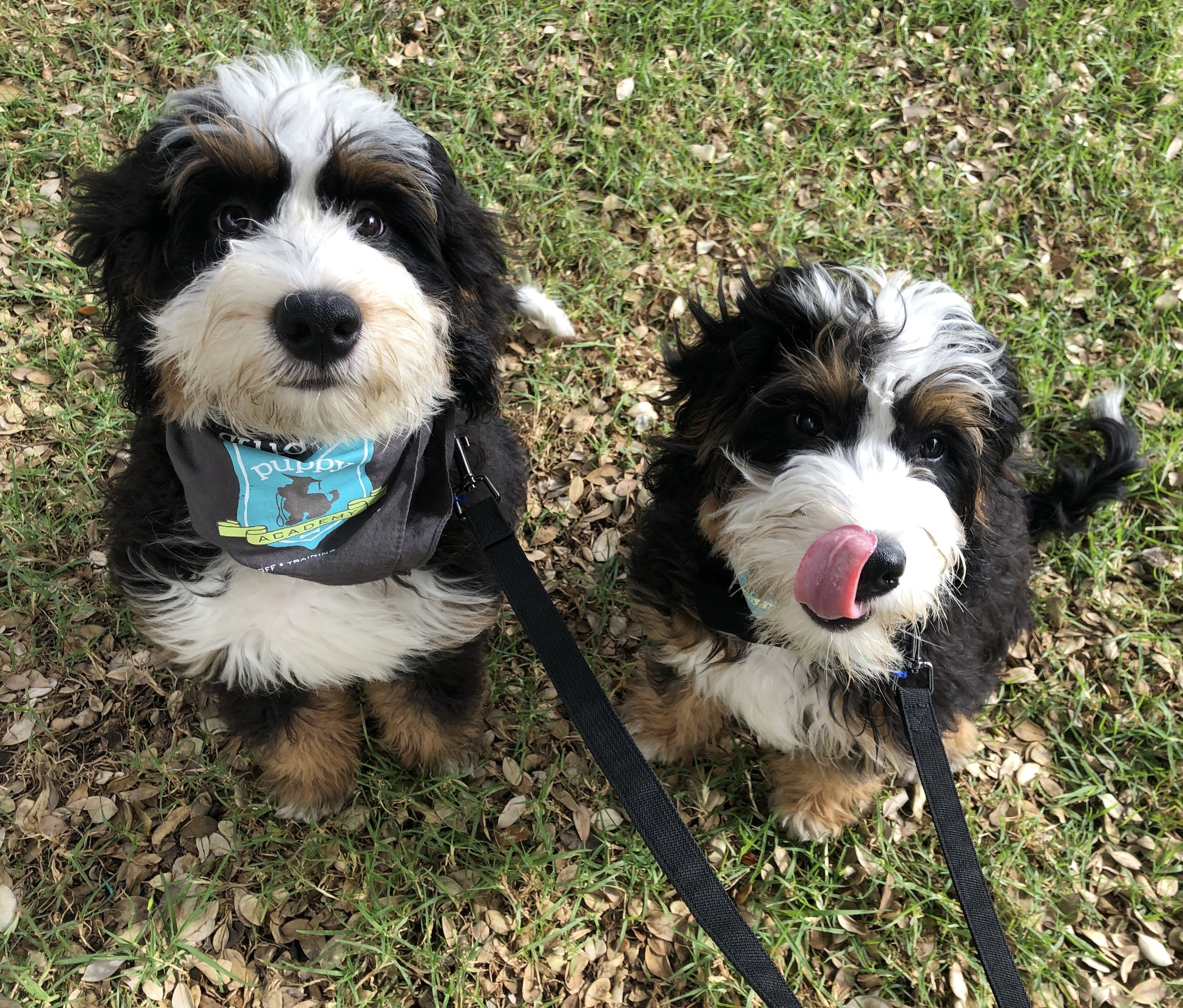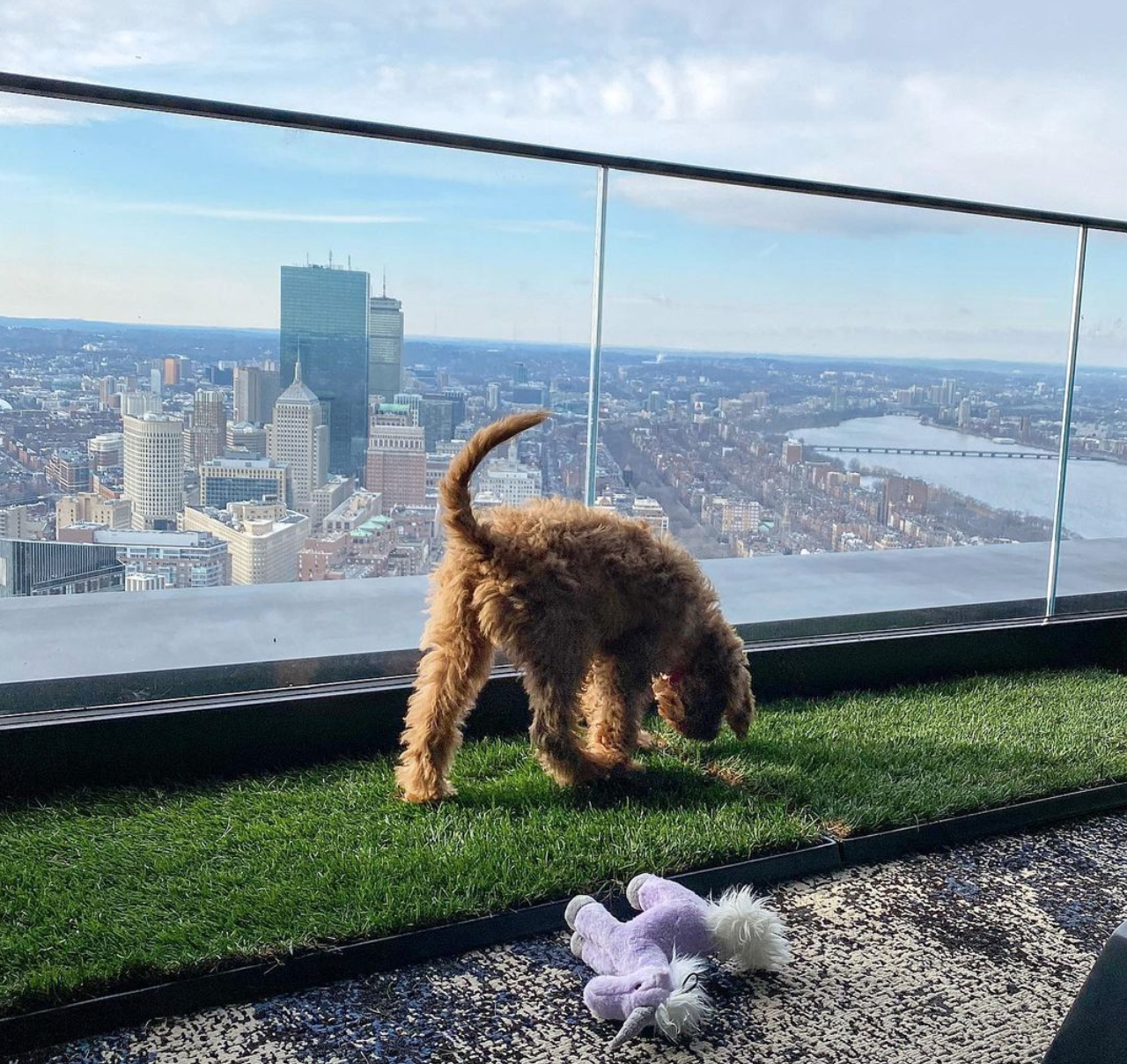In search of a new forever best friend? Not sure what puppy breed works best for you and your family? We’re giving you a deeper dive into popular dog breeds, from a puppy trainer’s perspective, to help you make this incredibly life-changing decision!
The Puppy Academy students, Buddy & Max!
When it comes to having the best of both worlds, Bernedoodles are it! These mixed breed designers pups were bred to be the perfect companion dog and quickly rose up in the ranks of popular puppy breeds over the last two decades!
How do you know if a Bernedoodle is a right fit for you and your family? We’re offering you a puppy trainer’s take on this breed, from their personalities, care needs, and of course, training advice to help you raise a wonderful adult dog!
A Brief Background on Bernedoodles!
The Berndoodle is a relatively new designer, that has been around since the early 2000’s. Sherry Rupke of Swissridge Kennels claims to be the very first breeder that purposely cross-bred two purebreeds: Standard Poodle and Bernese Mountain Dog.
Since this breed is only approximately two decades old, the American Kennel Club still does not consider the Bernedoodle a purebred. Nevertheless, the rise in popularity has also led to many more breeders producing these pups.
If you were interested in bringing a Bernedoodle home, while there are many reputable breeders that specialize in these pups, you can also find these pups in shelters or rescue groups that focus on Poodles and Bernese Mountain Dogs, to potentially find these mixed pups!
What are Bernedoodle Breed Characteristics?
When it comes to range, few breeds can beat the Bernedoodle! These pups come in a variety of sizes and coat colors.
Bernedoodles come in a few different sizes: tiny, miniature, medium, and standard. They can range in weight from ten pounds in the tiny category all the way to ninety pounds in the standard category.
Along with variety in sizes, their coats can be within a range from completely black, black and white, black and brown, or tri-colored with patches of either black, white, or brown. Probably the most common coat and markings people seek when looking for a Bernedoodle puppy is the tri-color variety that is in closer resemblance to the Bernese Mountain Dog.
Depending on which side of their genetic makeup your pup takes after, some Bernedoodle pups coats can be curly, or wavy like the Standard Poodle and not shed as much making them a good candidate for parents who suffer from allergies. Other Bernedoodle pups can have straighter coats that have a tendency to shed more and are not hypoallergenic.
What are Bernedoodles Personalities like?
The Puppy Academy student, Hamilton!
Goofy, smart, loyal to their families, and friendly, these pups have the best personality traits from both sides!
Most Bernedoodles parents pick these pups because of their good demeanors and temperaments. Your puppy may lean toward the Standard Poodle side, depicting traits of high intelligence, hard-working, and loyal. Or your puppy can lean toward the Bernese Mountain Dog which is good-natured, confident, and affectionate. Some Bernese Mountain Dogs can be stubborn, in particular during their adolescent phase, and a bit aloof or standoffish toward strangers.
With good basic obedience and early socialization, any Bernedoodle can make a great fit for a family and develop friendly demeanors toward new people. While these pups are considered to be working dogs and do require daily exercise, they are also content with hanging out with you at home. Moderate exercises such as one to two longer walks, with play sessions in between, a day is sufficient to burn off energy and keep your pup content! Tiny and Mini Bernedoodles are better equipment for urban environment living whereas Medium to Standard sized Bernedoodles would need more space to exercise and play.
What is a Bernedoodle’s Ideal Living Environment?
No matter the size of your Bernedoodle puppy, they are going to need adequate exercise, which is why they do really well with active families!
Tiny and Mini Bernedoodles will require a bit less activity and can adapt to tighter living spaces that come with urban environments such as apartments or condos.
As for Medium to Standard-sized Bernedoodles which are taller and wider and can grow upwards of ninety pounds, they may be bumping into more coffee tables and have trouble fitting in the same hallway as you in smaller dwellings!
For all sizes, access to either a fenced-in yard or a nearby park you can take them to is ideal for this breed!
JOIN US EACH WEDNESDAY AT 1 PM PT FOR OUR LIVE TRAINER Q&A SESSION ON @THEPUPPYACADEMY INSTAGRAM!
How to Care for Your Bernedoodle Puppy!
When it comes to caring for your new Bernedoodle puppy, start off by scheduling a first veterinarian visit within the first week of bringing your puppy home! During this visit, you and your pup’s vet can discuss your puppy’s nutritional needs, growth development, set up a vaccination and spay/neuter schedule, as well as provide you an opportunity to ask any questions related to your Bernedoodles health.
Like many large breed working dogs, Bernedoodle may suffer from joint dysplasia. Bernese Mountain Dogs have been known to suffer blood disorders, some cancers, and progressive retinal atrophy. Generally, Bernedoodles are healthy and sturdy especially if they come from a reputable breeder.
General care for your Bernedoodle puppy will include brushing their teeth to avoid tooth decay, gum disease, and bad breath. Floppy ears means they may be susceptible to ear infections so regularly check and clean them to avoid these from happening.
Because their coat types can vary, depending on your puppy, if they have a curly coat you may need to frequently brush them to avoid matting. We recommend that you take your puppy to a professional groomer every few months to get their fur trimmed.
NEED HELP TRAINING YOUR PUPPY? JOIN THE ONLINE PUPPY SCHOOL!
Puppy Trainer’s Advice for Raising a Well-Behaved Bernedoodle!
The Puppy Academy student, Cali!
1. Create a Daily Puppy Training Schedule
Bernedoodle puppies are smart and easily trained but they can have a stubborn streak as they get into their adolescence. Creating early structure at home can help mitigate this stubbornness by establishing daily routines your puppy can expect and also establish you as leader.
Create a puppy schedule to include your puppy’s daily activities: feeding, sleeping, playtime, and puppy training sessions. Since Bernedoodles are made up of two intelligent hard-working breeds, basic obedience training with food positive reinforcement will benefit their behavioral growth!
2. Socialize Your Bernedoodle Puppy with People, Children, and Other Pets
Bernedoodles have friendly dispositions and make great family dogs, however, they can be standoffish to new people as they get older. So it’s essential to have early socialization with new people, children and other pets, and continue it as they grow. It’s also important to properly teach your children how to interact with the new puppy and include them in your puppy’s training.
Introduce your puppy to new people and dogs in a controlled way, on a leash and when they are calmly sitting (if you need help on your puppy’s calm greet, check out our blog “Puppyhood Made Easy for New Owners: Teach Your Puppy How to Calmly Greet New People!”) to avoid them from jumping up or getting overly excited.
3. Use Play to Help Train Them
Tap into their playful nature and use your playtime sessions together to teach good manners! For example, use Fetch to teach your Bernedoodle how to come to you, Drop-it to give the toy back, then ask them to sit to teach polite manners as they learn to wait until you toss the toy again for them to get.
Check out our “Puppyhood Made Easy for New Owners: How to Play with Your Puppy Pt.1!” blog for more tips!
4. Change Up Your Bernedoodle’s Training!
Although Bernedoodles love to work, they sometimes need a bit more motivation! This can come with the aid of food rewards, and providing variation to their training routines to keep them engaged.
Enrolling your puppy in training classes, or working with them by yourself at home using a program like our online puppy school will give you a plan to follow with basic training routines to teach your Bernedoodle good manners, as well as keep challenging them along the way so they never get bored, and advance their skillset!
Did you recently bring home a Bernedoodle puppy? Are you still planning and not sure what breed fits your lifestyle? Let us know in the comments! We’re available to answer questions live every Wednesday at 1 pm PT on @thepuppyacademy Instagram.
Check out these blogs related to puppy training and more!
A Guide to Puppy Breeds: American Pit Bull Terrier!







